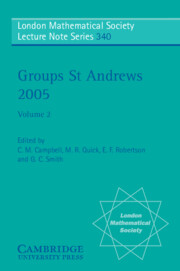Book contents
- Frontmatter
- Contents
- Introduction
- 1 Groups and semigroups: connections and contrasts
- 2 Toward the classification of s-arc transitive graphs
- 3 Non-cancellation group computation for some finitely generated nilpotent groups
- 4 Permutation and quasi-permutation representations of the Chevalley groups
- 5 The shape of solvable groups with odd order
- 6 Embedding in finitely presented lattice-ordered groups: explicit presentations for constructions
- 7 A note on abelian subgroups of p-groups
- 8 On kernel flatness
- 9 On proofs in finitely presented groups
- 10 Computing with 4-Engel groups
- 11 On the size of the commutator subgroup in finite groups
- 12 Groups of infinite matrices
- 13 Triply factorised groups and nearrings
- 14 On the space of cyclic trigonal Riemann surfaces of genus 4
- 15 On simple Kn-groups for n = 5, 6
- 16 Products of Sylow subgroups and the solvable radical
- 17 On commutators in groups
- 18 Inequalities for the Baer invariant of finite groups
- 19 Automorphisms with centralizers of small rank
- 20 2-signalizers and normalizers of Sylow 2-subgroups in finite simple groups
- 21 On properties of abnormal and pronormal subgroups in some infinite groups
- 22 P-localizing group extensions
- 23 On the n-covers of exceptional groups of Lie type
- 24 Positively discriminating groups
- 25 Automorphism groups of some chemical graphs
- 26 On c-normal subgroups of some classes of finite groups
- 27 Fong characters and their fields of values
- 28 Arithmetical properties of finite groups
- 29 On prefrattini subgroups of finite groups: a survey
- 30 Frattini extensions and class field theory
- 31 The nilpotency class of groups with fixed point free automorphisms of prime order
20 - 2-signalizers and normalizers of Sylow 2-subgroups in finite simple groups
Published online by Cambridge University Press: 20 April 2010
- Frontmatter
- Contents
- Introduction
- 1 Groups and semigroups: connections and contrasts
- 2 Toward the classification of s-arc transitive graphs
- 3 Non-cancellation group computation for some finitely generated nilpotent groups
- 4 Permutation and quasi-permutation representations of the Chevalley groups
- 5 The shape of solvable groups with odd order
- 6 Embedding in finitely presented lattice-ordered groups: explicit presentations for constructions
- 7 A note on abelian subgroups of p-groups
- 8 On kernel flatness
- 9 On proofs in finitely presented groups
- 10 Computing with 4-Engel groups
- 11 On the size of the commutator subgroup in finite groups
- 12 Groups of infinite matrices
- 13 Triply factorised groups and nearrings
- 14 On the space of cyclic trigonal Riemann surfaces of genus 4
- 15 On simple Kn-groups for n = 5, 6
- 16 Products of Sylow subgroups and the solvable radical
- 17 On commutators in groups
- 18 Inequalities for the Baer invariant of finite groups
- 19 Automorphisms with centralizers of small rank
- 20 2-signalizers and normalizers of Sylow 2-subgroups in finite simple groups
- 21 On properties of abnormal and pronormal subgroups in some infinite groups
- 22 P-localizing group extensions
- 23 On the n-covers of exceptional groups of Lie type
- 24 Positively discriminating groups
- 25 Automorphism groups of some chemical graphs
- 26 On c-normal subgroups of some classes of finite groups
- 27 Fong characters and their fields of values
- 28 Arithmetical properties of finite groups
- 29 On prefrattini subgroups of finite groups: a survey
- 30 Frattini extensions and class field theory
- 31 The nilpotency class of groups with fixed point free automorphisms of prime order
Summary
Abstract
We survey the recent completion of the determination of the maximal 2-signalizers and the normalizers of Sylow 2-subgroups in all finite simple groups.
Introduction
In this survey we discuss the recent completion of the determination of the maximal 2-signalizers and the normalizers of Sylow 2-subgroups in all finite simple groups (see).
The notion of signalizer introduced by Thompson in plays an important rôle in finite group theory, in particular, in the method of signalizer functor. If G is a finite group, p is a prime and P is a Sylow p-subgroup of G, then any P-invariant p′-subgroup of G is called a P-signalizer or simply a p-signalizer. The case of 2-signalizers is of the greatest interest. In, the second author disproved Thompson's conjecture on the commutativity of 2-signalizers in finite simple groups. He constructed certain examples of finite simple groups with nilpotent 2-signalizers of any class of nilpotency and even with non-nilpotent 2-signalizers. In connection with announcing the classification of finite simple groups, Gorenstein posed the problem of the study of the properties of signalizers in known finite simple groups. It was known that the 2-signalizers in finite simple groups of Lie type over a field of even characteristic are trivial (see [9, Thm. 4.254]) and a non-trivial 2-signalizer in the alternating group An exists only in the case n ≡ 3 (mod 4) and has order 3 (see [9, Thm. 4.255(i)]).
- Type
- Chapter
- Information
- Groups St Andrews 2005 , pp. 586 - 596Publisher: Cambridge University PressPrint publication year: 2007
- 1
- Cited by



